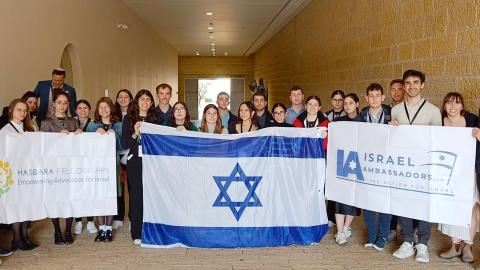Ancient Seed Growing in Israeli Desert Believed to Be Biblical Balm
KIBBUTZ KETURA, Israel – A 1,000-year-old seed that germinated years ago could be a biblical balm known for its healing qualities – a plant that seemingly disappeared. CBN News went to the desert to see the plant and meet those working with it.
It's happening deep in the Negev Desert, at Kibbutz Ketura. Here, experts are growing a tree they believe was mentioned in the Bible and lost a long time ago.
When they planted the ancient seed 14 years ago, they had no idea what it would become. Now, they believe it could be a unique kind of tree found in scripture.
"This is a miracle. It's a resurrection," declared Dr. Sarah Sallon, director of the Natural Medicine Research Center at the Hadassah Medical Organization. She heads the Sheba Project at Hadassah.
A pediatrician by profession, Sallon became interested in traditional uses for plants for food, medicine, spices, and dyes.
She and Dr. Elaine Solowey, who supervises the Center for Sustainable Agriculture at Kibbutz Ketura's Arava Institute, started a small plantation called the Middle East Medicinal Plant Project.
"And from there," Sallon told us. "I got very interested not only in the plants that grow here now, but the plants that grew here a long time ago – especially plants that are mentioned in the Bible."
That led Sallon to begin a search that would ultimately lead to a tree they've nicknamed Sheba.
Sallon explained, "It's a tree that was grown from an ancient seed – a thousand-year-old seed – that was found in the Judean desert about 40 years ago by Professor Joseph Patrick a professor of archeology at the Hebrew University, when he was excavating caves about five kilometers west of Jericho."
After years of in-depth scientific and biblical research, and consultations with experts around the world, they believe this tree is prominent in the Bible.
In the book of Genesis, which dates to about at least the story of Jacob and his sons to about 1800 (BC)," Sallon said. "We call this the Middle Bronze Age. That's when that period has been dated to. We find (a) reference to something called tsori, or tsa'ori" – okay? And it's a resin from a tree or a bush."
Sallon says "Tsori," translated as "balm," is often mentioned in connection with something of value here.
Something of the land, this land, the land of Israel, and something connected with healing, especially when it's talked about by Jeremiah and later by Ezekiel, who were in the 7th century, BCE."
Sallon gave the seed to Solowey.
Solowey noted, "An odd seed – I had never seen a seed like it before. Someone said to me, 'It's an olive,' and I said, 'No it's not an olive!' And somebody else said, 'It's an apricot.' So I said 'No, it's not an apricot!' So I planted it."
Solowey carefully watered it and treated it as she did other ancient seeds.
"I gave them antibiotic fertilizer and – to my astonishment – it became this funny little shoot with the hat on it," she stated.
"Sallon elaborated, "And when the little green chute emerged, we didn't know what that was either. So I sent pictures all the way around the world, and one of the botanists who I sent it to wrote back and said, "You've grown a Commiphora, a species.'"
Commiphora is the Latin name of a genus that means "giver of resin," a sticky substance in some plants that can be used to make medicine.
"And it's part of the family of trees, bushes in which myrrh and frankincense belong," Sallon told us. "Some of the most famous incense trees in history belong to this family. But not all members of it are fragrant."
This one is unknown to experts around the world.
They think that what they grew is the "tsori," which is mentioned in the Bible and was a resin-producing tree associated with healing. Tsori has been confused with the Judean Balsam, a true "balm" because it was fragrant and cultivated for over 1000 years at an oasis around the Dead Sea. The word balm comes from the Hebrew “bosem” meaning fragrant. Yet, Sheba is not fragrant, but full of medicinal compounds.
"In the databases, there didn't seem to be anything that was quite like this tree. So eventually what we started to test is raise its resin. And I found out that there was something very strange about it," Solowey said.
The tree has been growing for 14 years, and Solowey says they still don't know much about it, but she believes it's valuable.
"It could be an extinct tree. It could be the tsori, and we're going to plant it," Solowey stated. "I'm very pleased with this tree, right? That it's nice and beautiful. And I do feel the difference. And I feel that it come back to us from a long time (ago)."
Sallon and Solowey have worked together for years. They planted 2,000-year-old date palm seeds. The first one to sprout was "Methuselah" which CBN News first "met" in 2011. Methuselah and some other date palms are growing well, and today it is a thriving plant.
Referring to their new tree, both Saloway and Sallon say there's a message for today: "That there is healing in the world. We just have to find it."
"This is a very dark time – a very dark time for all the people of this area, whoever they are, Jewish, Christian, (and) Muslims," Sallon related.
She added, "And in this dark time, it's a kind of resurrection in a way. It's something that hasn't been seen for thousands of years. I think to me it represents light and hope."
***Please sign up for CBN Newsletters and download the free CBN News app to ensure you receive the latest updates and alerts.***





